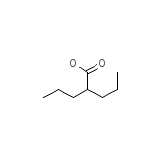Valproic acid USP




Valproic acid USP Brand names, Valproic acid USP Analogs
- 2 PP (base)
- Alti-Valproic
- Bruceine D
- Convulex
- DPA
- DPA (VAN)
- Delepsine
- Depakene
- Depakine
- Deproic
- Di-n-propylacetic acid
- Di-n-propylessigsaure
- Dipropylacetic acid
- Dom-Valproic
- Epilex
- Epilim
- Epival
- Ergenyl
- Kyselina 2-propylvalerova
- Med Valproic
- Mylproin
- Myproic Acid
- Novo-Valproic
- Nu-Valproic
- PMS-Valproic Acid
- Penta-Valproic
- Pentanoic acid, 2-propyl-
- Propylvaleric acid
- Sodium hydrogen divalproate
- Sprinkle
- Valcote
- Valeric acid, 2-propyl-
- Valparin
- Valproate semisodique [French]
- Valproate semisodium
- Valproato semisodico [Spanish]
- Valproatum seminatricum [Latin]
- Valproic acid USP
- Valproic acid USP24
- Valproic acid semisodium salt (2:1)
- n-DPA
- n-Dipropylacetic acid
Valproic acid USP Brand Names Mixture
- No information avaliable
Valproic acid USP Chemical_Formula
C8H16O2
Valproic acid USP RX_link
http://www.rxlist.com/cgi/generic2/depakene.htm
Valproic acid USP fda sheet
Valproic acid USP msds (material safety sheet)
Valproic acid USP Synthesis Reference
Oberreit, Ber.29, 1998 (1896)
Valproic acid USP Molecular Weight
144.211 g/mol
Valproic acid USP Melting Point
120 - 130 oC
Valproic acid USP H2O Solubility
Slightly soluble (1.3 mg/mL)
Valproic acid USP State
Solid
Valproic acid USP LogP
2.549
Valproic acid USP Dosage Forms
Capsule (250 mg); Syrup (250 mg drug/5mL syrup)
Valproic acid USP Indication
For use as sole and adjunctive therapy in the treatment of simple and complex absence seizures, and adjunctively in patients with multiple seizure types which include absence seizures.
Valproic acid USP Pharmacology
Valproic Acid is an anticonvulsant and mood-stabilizing drug used primarily in the treatment of epilepsy and bipolar disorder. It is also used to treat migraine headaches and schizophrenia. In epileptics, valproic acid is used to control absence seizures, tonic-clonic seizures (grand mal), complex partial seizures, and the seizures associated with Lennox-Gastaut syndrome. Valproic Acid is believed to affect the function of the neurotransmitter GABA (as a GABA transaminase inhibitor) in the human brain. Valproic Acid dissociates to the valproate ion in the gastrointestinal tract. Valproic acid has also been shown to be an inhibitor of an enzyme called histone deacetylase 1 (HDAC1). HDAC1 is needed for HIV to remain in infected cells. A study published in August 2005 revealed that patients treated with valproic acid in addition to highly active antiretroviral therapy (HAART) showed a 75% reduction in latent HIV infection.
Valproic acid USP Absorption
Rapid absorption from gastrointestinal tract.
Valproic acid USP side effects and Toxicity
Oral, mouse: LD50 = 1098 mg/kg; Oral, rat: LD50 = 670 mg/kg. Symptoms of overdose may include coma, extreme drowsiness, and heart problems.
Valproic acid USP Patient Information
Since valproate products may produce CNS depression, especially when combined with another CNS depressant (eg, alcohol), patients should be advised not to engage in hazardous activities, such as driving an automobile or operating dangerous machinery, until it is known that they do not become drowsy from the drug.
Valproic acid USP Organisms Affected
Humans and other mammals














